The topic of satellite communications is very complex, since it combines not only technical and commercial issues, but also issues of international interaction between individual countries in the use of the common frequency spectrum for mankind, in the field of this project and its capabilities, the majority of the population has a lot delusions.
As far as possible, I tried to talk about satellite communications (which I gave more than 27 years of my life and in general achieved something) and the StarLink project in particular, in my blog, but now there is a lot of accumulated material about this project, and an understanding of what is actually not people who are not from our narrow industry understand (are mistaken), led me to the idea to systematize the accumulated knowledge about this project, and publish it in a certain unified form, trying to make this description interesting and accessible for an ordinary reader interested in technology and space, as well as useful for my fellow communications workers.
It is up to you to judge what came out of this and what did not. As far as I can and will, I will update the content (because the project is rapidly developing and changing on the fly) and answer your questions.
Sergey Pekhterev, Ph.D.
1. The birth of the Starlink project
If you look for where this project grew from, then, most likely, you need to take 2007 as a starting point, when Greg Wyler founded O3b Networks, whose shareholders were the satellite operator SES (he owned 49.5% of the shares), Google, HSBC bank, Liberty Global Foundation.

Photo: Greg Wyler
In 2016, SES bought out stakes from the remaining shareholders of O3b Networks, and this was a recognition of the success of both the company and Greg Wyler as a leader, and the prospects for this business line. Recall that O3b is an abbreviation for Other 3 billion: a reminder of the three billion earthlings who did not have access to the Internet in 2007. The essence of that project was to create a constellation of satellites in an orbit 8000 km from the Earth above the equator, which would provide broadband Internet to the world's population living between 45 degrees south and 45 degrees north latitude. An obvious drawback of the project was that to receive the Internet, a complex of two antennas with a diameter of 2.4 m and a cost of $ 120 thousand was needed. Two antennas were needed because one received a signal, tracking a flying satellite,while the second antenna was aiming at the next spacecraft in order to replace the first one when "her" satellite disappeared behind the horizon.
Such a service has been adopted by the governments and telecoms of African countries, island states in the Pacific Ocean, as well as the Pentagon for its overseas bases. That is, the business was a success, the network resource was sold out. But due to the enormous cost of antennas, this service could not be used by residents of villages in the depths of Africa, and even just individuals. What was needed was a "personal satellite Internet" project based on satellites in low orbit.
And such a project appeared inside Google, where Mark Krebs got a job in 2013.
On September 30, 2014, Google applied for a patent for a satellite constellation for broadband Internet access with a network of gateway ground stations and inter-satellite links, in which Mark Krebs was listed as the inventor.
The patent was issued already in 2017, this is how the constellation of satellites should look like:
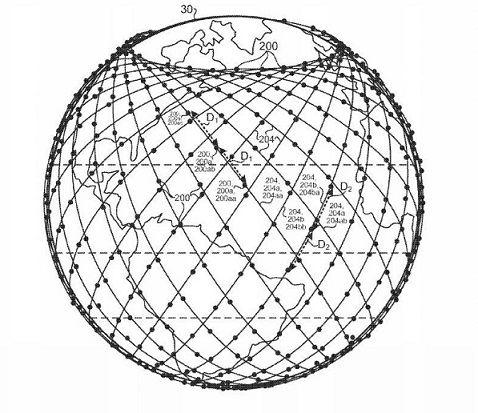
Thus, we can say for sure that in 2013-2014. Google was working on a satellite project for broadband internet access internally, with Mark Krebs and Greg Wyler as active contributors. The latter decided to involve Elon Musk in this project, who was just laying the foundations for his future success, switching to version 1.1 of the Falcon 9 rocket and docking the Dragon cargo spacecraft to the ISS. The mask was assigned the role of a "cab" for the delivery of satellites into space and a "locksmith" for their manufacture.
What and how happened in 2014 between the leadership of Google, Elon Musk and Greg Wyler, I cannot say: we have to wait until they all release their memoirs and read who, what, who said and who sent whom where, but the result is known. Greg Wyler parted ways with Google and started his own project OneWeb (WorldVu), and Elon Musk secured funding from Google and started a similar project in 2014.
Note that most likely. 2014 was a very turbulent year, and the negotiations between the parties were quite tense, and the parties were preparing for the fact that their joint business would not take place. At least it is known that on June 27, 2014, an application was made to the International Telecommunication Union (ITU) on behalf of the Norwegian communications regulator for a satellite network of 4,257 satellites called STEAM. The network consisted of two groups: STEAM-1 was announced in the Ku-band, and STEAM-2 was designed as a Ka-group; its 4,257 satellites were distributed between 43 orbital planes. The initiator of this ITU application was Steam Systems, founded in 2014 by the law firm Schjødt. In 2018, the registry of owners of Steam Systems was changed and now SpaceX is 100% owner.Norway's advantage over the United States was the absence of a fee, which was charged by the American industry regulator Federal Communication Commission (FCC) - it demanded almost $ 1 million, and in the absence of bureaucracy. As a reminder, the FCC has been reviewing SpaceX's 2016 application for almost two years, scrutinizing claims from all competitors.
Thus, we can say that the parental home for the Starlink project is Google, and Greg Wyler and Mark Krebs are claiming the role of parents (in 2016, Mark moved to SpaceX, in 2018 Elon Musk kicked him out of there, and since 2018 Krebs has been working on the Amazon Kuiper project by Jeff Bezos). But real life in Starlink was breathed by Elon Musk, who caught fire with this idea in 2014. Here is Musk's first mention of the upcoming Starlink project:

2. Main events of the Starlink project
January 2015 - Opening of an office in Redmond, Washington, created specifically to develop the Starlink project.
November 15, 2016 - filing an application with the FCC for the use of the frequency spectrum of the Ku and Ka bands by a satellite constellation of 4425 spacecraft.
March 1, 2018 - filing an application for the use of the V-band frequency spectrum by a satellite constellation of 7,518 spacecraft.
March 30, 2018 - FCC cleared for November 2016 filing for a network of 4,425 satellites.
February 22, 2018 - Two test satellites (Microsat-2a and Microsat-2b) were successfully launched by the Falcon 9 launch vehicle as a passing load. They were subsequently renamed Tintin-A and Tintin-B.
October 2018- reorganization of the office in Redmond with the dismissal of seven employees, including two top managers of the Starlink project. Among those dismissed were the vice-president for satellite direction Rajiv Badyal and one of the chief designers, Mark Krebs, who was involved in the satellite Internet project at Google. Elon Musk replaced them, giving the new leaders the task of launching satellites in mid-2019.
November 8, 2018 - filing an application with the FCC to change the application of the Ku and Ka bands network (4425 satellites), with the allocation of the first stage of 1600 satellites and a decrease in the orbit height for them from 1100 km to 550 km.
November 15, 2018 - FCC cleared for network on March 1, 2017 application of 7,518 satellites in the V-band.
December 20, 2018- The US Air Force's Strategic Development Planning and Experiments Division awarded SpaceX a $ 28 million contract to test various military uses of the Starlink satellite network over the next three years.
February 1, 2019 - Space X has submitted a request to the FCC to turn on and operate 1 million subscriber terminals.
April 8, 2019 - SpaceX approves a license to operate a private Earth remote sensing system. Thus, SpaceX gets the right to take pictures of both its own satellites and the Earth. Permission issued for low resolution color imagery for 60 spacecraft in a circular orbit with an inclination of 53 °.
April 26, 2019- The FCC has approved SpaceX's application to change the previously announced Ku-band network. Now we are talking about 1584 satellites at an altitude of 550 (instead of 1150) km and an inclination of 53 °.
May 2019 - videos from the Starlink train begin to appear on the Internet - numerous satellites of this group looked like a moving train in the night sky. The admiring exclamations of the spectators begin to be accompanied by the indignation of astronomers. The epic "SpaceX vs astronomical community" begins.
May 23, 2019 - Launch of 60 Starlink satellites in version v0.9 (Earth-to-space Ku-band feeder link). First public photos of satellites and their packing under the fairing of a Falcon 9 rocket.
28 June 2019... - SpaceX has filed a notice to the FCC about the start of ground terminal tests. These are about 200 flat phased array terminals and ten with a parabolic antenna.
August 30, 2019 - SpaceX submits another application to the FCC to change the characteristics of the constellation: now the first stage of the Starlink network should consist of 72 orbital planes, not 24. Accordingly, the number of satellites in each plane changes: instead of 66 there will be only 22.
October 7, 2019 - SpaceX has asked the FCC to submit 20 applications to ITU for 30,000 low-orbit satellites.
November 11, 2019 - launch of 60 Starlink spacecraft version 1.0. The altitude of the circular orbit of separation of satellites from the rocket is 280 km, that is, significantly lower than in the first launch.
20 November 2019- The ITU World Radiocommunication Conference (WRC) decided on the time that operators of low-orbit satellite constellations have to fully deploy their systems. From the moment ITU receives an application (they are submitted by the national administration of the country in which the operator of the constellation is located) for the allocation of the frequency spectrum for the operator's satellite network, the countdown begins at 7 years. No later than 7 years later (otherwise the application will be canceled), the operator must start deploying its satellite network in such a way that 10% of spacecraft are launched in the first 2 years, 50% within the first five years, and the entire constellation (100% of declared satellites ) after 7 years. If the operator fails to do so, its spectrum rights are limited in proportion to the number of satellites launched by the end of those seven years.
January 7, 2020 - third launch of 60 Starlink spacecraft (second launch of version 1.0 satellites).
January 29, 2020 - fourth launch of 60 Starlink spacecraft (third launch of version 1.0 satellites).
February 4, 2020 - The Australian Communications and Media Authority has made SpaceX licensed to provide services in Australia.
February 17, 2020 - the fifth launch of 60 Starlink spacecraft (the fourth launch of version 1.0 satellites).
March 18, 2020 - the sixth launch of 60 Starlink spacecraft (the fifth launch of version 1.0 satellites).
April 17, 2020... SpaceX is submitting a request to the FCC to change the architecture of the Starlink Ku / Ka-band network. All satellites will operate in orbits between 540 and 570 km.
April 22, 2020 - seventh launch of 60 Starlink spacecraft (sixth launch of version 1.0 satellites).
April 23, 2020 - Elon Musk announces on Twitter that closed beta tests of Starlink services will begin in about 3 months, and public ones in about 6 months.
May 17, 2020 - The first photos of the STS for the Starlink network appeared, the photo was taken at the gateway in Merrilan, Wisconsin.
2020 g of 20 May . SpaceX has applied for a Basic International Telecommunications Services (BITS) license, which entitles you to provide communications services in Canada.
June 1, 2020SpaceX has filed an application with the FCC for the 2nd generation of the Starlink network of 30,000 satellites in orbits ranging from 328 to 614 km.
June 4, 2020 - the eighth launch of 60 Starlink spacecraft (the seventh launch of version 1.0 satellites). One of the satellites has a VisorSat to reduce its visibility.
June 13, 2020 - the ninth launch of 58 Starlink spacecraft (the eighth launch of version 1.0 satellites). Additionally, three SkySat satellites were launched.
June 14, 2020 - registration of those wishing to participate in beta testing opens on the www.starlink.com website .
June 21, 2020 - information about Wi-Fi router for Starlink terminal appeared. The router has received FCC certification and will be manufactured in Taiwan.
August 1, 2020- the first test results of the Starlink service appeared on the Internet: speeds up to 60 Mbps, latency from 31 ms.
4 2020 g of August . - SpaceX turned to the FCC with a request to expand the previously requested permission for 1 million subscriber terminals to 5 million, justifying it by the fact that great interest was shown in its system and the company received 700 thousand applications for testing.
2020 g of 7 August . - tenth launch of 57 Starlink spacecraft (ninth launch of satellites version 1.0). Additionally, 2 BlackSky satellites were launched.
August 18, 2020 - the eleventh launch of 58 Starlink spacecraft (the tenth launch of version 1.0 satellites). Additionally, 3 SkySat satellites were launched.
September 3, 2020- twelfth launch of 60 Starlink spacecraft (eleventh launch of satellites version 1.0).
September 3, 2020 - SpaceX announces that it has successfully tested a laser link between two Starlink satellites.
October 6, 2020 - thirteenth launch of 60 Starlink spacecraft (twelfth launch of version 1.0 satellites).
October 15, 2020 - Canadian telecom regulator CRTC has approved the issuance of a BITS license to Space X to provide basic communications services in Canada
October 18, 2020 - the fourteenth launch of 60 Starlink spacecraft (thirteenth launch of version 1.0 satellites).
2020 g of 24 October . - the fifteenth launch of 60 Starlink spacecraft (the fourteenth launch of version 1.0 satellites).
October 2020 g 27 . - Space X is launching a public beta program under the slogan 'Better Than Nothing'. Beta test participants are invited to redeem terminals at $ 499 (plus state tax and shipping costs) and a subscription fee of $ 99 per month without limiting traffic. The promised speed will be in the range of 50-150 Mbps, with possible interruptions in communication. In 2021, a significant improvement in the quality of service is promised due to software updates and an increase in the number of satellites.
October 27, 2020 - Space X is launching a public beta program under the slogan 'Better Than Nothing'. Beta test participants are invited to redeem terminals at $ 499 (plus state tax and shipping costs) and a subscription fee of $ 99 per month without limiting traffic. The promised speed will be in the range of 50-150 Mbps, with possible interruptions in communication. In 2021, a significant improvement in the quality of service is promised due to software updates and an increase in the number of satellites.
3. Goals and cost of the project
In January 2015, when opening an office in Redmond, Elon Musk noted:
- “We want to change the situation with Internet traffic in space. Our goal is for approximately 10% of local traffic and 50% of "long distance" (long distance and international) Internet traffic to go through the satellite network.
- [] , .
- [ Starlink] . — $10-15 , .
- $100 $300 .
- , Starlink ».
In January 2017, the Wall Street Journal published an article by two American journalists, Andy Pazstor and Rolf Winkler, who somehow got access to SpaceX's 2015 business plans. According to these business plans, the Starlink project was supposed to overtake SpaceX's business in launching satellites into space in 2020, and by 2025 SpaceX expected Starlink's revenue to be up to $ 30 billion per year (6 times more than it would give missile business) and the company will serve 40 million subscribers (the ARPU level in this case would be $ 62 per month). At the same time, Starlink's operating income was supposed to exceed $ 15 billion per year.
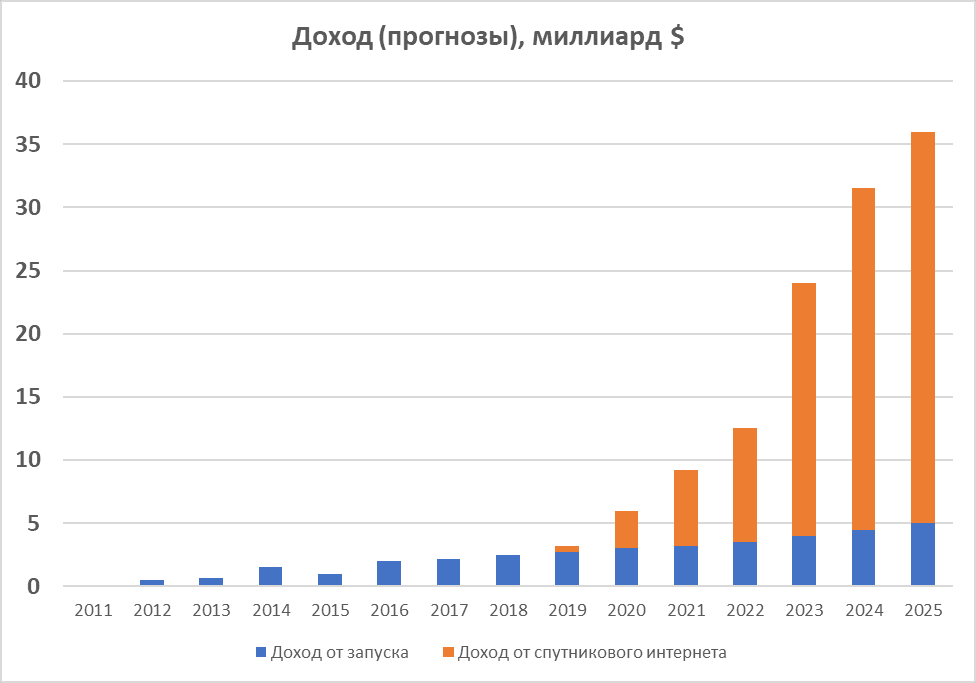
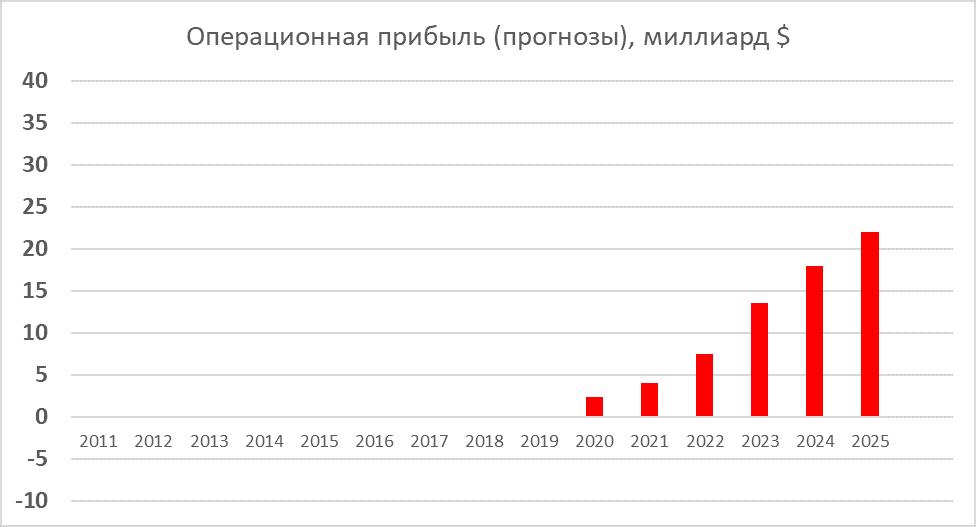
How much the goals announced in 2015-2016 will correspond to the harsh reality, we are likely to see already in 2021. However, we note that the total revenue of the five largest satellite operators in the world: Intelsat, SES, Inmarsat, Telesat and Eutelsat - amounted to $ 7.75 billion in 2019, against which the goal of SpaceX to have a turnover of $ 30 billion in 2025 looks very, very optimistic ...
Funding for the project comes from raising funds from new and old SpaceX shareholders. The placement of shares is closed, and only the amount of funds raised is known. So, for example, in the first half of 2019 alone, SpaceX raised $ 1.02 billion from shareholders.In August 2020, SpaceX reported to the SEC on raising almost $ 2 billion in the company's capital.
According to Morgan Stanley analysts' estimates, published in July 2020, the Starlink project will not reach positive cash flow until 2033.
4. The composition of the Starlink group
Speaking about the composition of SpaceX's Starlink low-orbit constellation, it should be noted that it consists of at least two separate satellite networks. The first network was originally planned (according to SpaceX's filing with the FCC on November 15, 2016) of 4,425 satellites. This application was approved by the FCC on March 29, 2018.

It should have looked like this:

The second network of 7,518 satellites will have to operate in the V-band (application filed March 1, 2017, approved November 19, 2018).
Starlink VLEO constellation:

Then SpaceX made changes in 2018, lowering the orbit to 550 km. The table below shows the composition of the group, according to SpaceX's latest application to the FCC on April 17, 2020 (the application has not yet been approved by the FCC):

Also note that in early June 2020, SpaceX sent more one application called Generation 2, according to which almost 30,000 more satellites are planned in the following orbits:
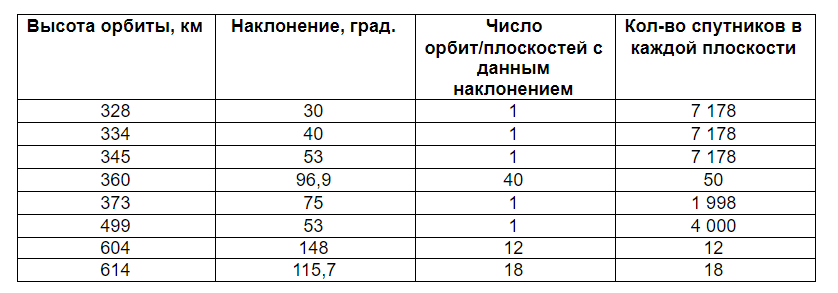
However, in this review we will focus on the analysis of the first stage of the Ku / Ka-band network, which is really being deployed now and has a chance to start providing Internet access in the near future (end of 2020). At the moment, SpaceX sees it in the following form: 72 orbital planes with an inclination of 53 degrees, 22 satellites in each at an altitude of 550 kilometers (it is possible that this is not the final version). It looks like this:
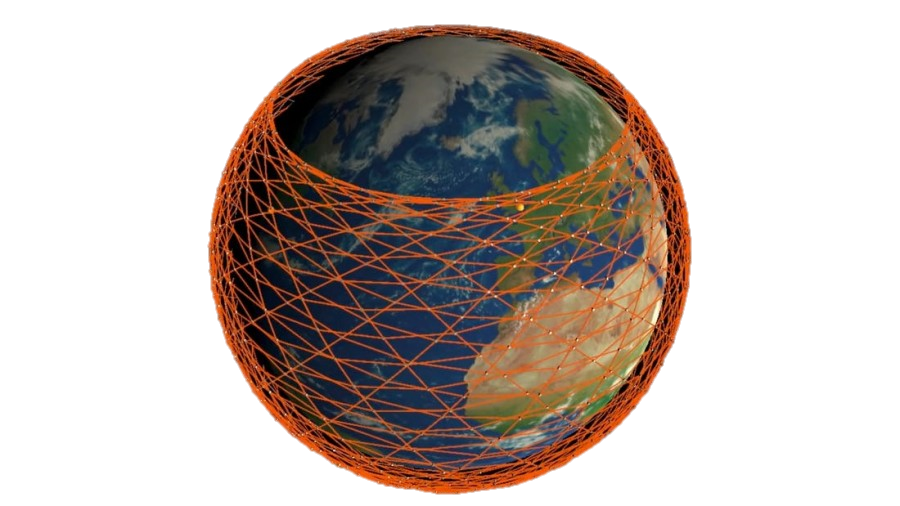
5. Starlink network architecture
The figure shows the architecture of the Starlink network and its most important components, namely: The
space segment - these are satellites in low orbit (at the moment, the first 1600 satellites are deployed in an orbit with an altitude of 550 km with an inclination of 53 degrees);
Ground segment :
- Network Management System,
- Gateway stations,
- User Terminal

As for the terrestrial network, in fact, it is built on the Google network. SpaceX itself has two autonomous networks registered - AS14593 and AS27277 (the latter is possibly used for SpaceX's internal IT network). Based on the available data, SpaceX subscriber traffic will be routed through leased fiber-optic lines (mainly Google's own network, where possible) to the nearest nodes / traffic exchange points in the United States: LAX (Los Angeles), SEA (Seattle), ORD (Orlando), LGA (New York), SJC (San Jose), DFW (Dallas), IAD (Washington). In his tweet dated 10/2/2020, Elon Musk announced that the company will try to place Gateways directly on the buildings where the "servers" are located, apparently implying. namely, Internet traffic exchange centers.
As of 2/11/2020, SpaceX has IP addresses of Australia, New Zealand, Canada, Great Britain, Germany and Spain registered in AS (an autonomous system, in fact, the identifier of the provider under which the IP addresses are registered). AS36492 is used by Google under the name "GOOGLEWIFI" to launch public Wi-Fi hotspots, but also used by Starlink for their IPs).
For Australia and New Zealand there are two ranges:
IPv4
103.152.126.0/24 Starlink Sydney PoP 1 user addresses (New Zealand)
103.152.127.0/24 Starlink Sydney PoP 2 user addresses
IPv6
2406: 2d40: 1000 :: / 36 Starlink Sydney PoP 2 user addresses
2406: 2d40 :: / 36 Starlink Sydney PoP 1 user addresses (New Zealand)
Canada:
143.131.2.0/24 SpaceX Canada Corp.
143.131.3.0/24 SpaceX Canada Corp.
143.131.4.0/24 SpaceX Canada Corp.
143.131.5.0/24 SpaceX Canada Corp.
143.131.6.0/24 SpaceX Canada Corp.
143.131.7.0/24 SpaceX Canada Corp.
For Europe:
162.43.192.0/24 SpaceX Services, Inc. (ES, Madrid)
162.43.193.0/24 SpaceX Services, Inc. (ES, Madrid)
176.116.124.0/24 SpaceX Services, Inc. (UK, London)
176.116.125.0/24 SpaceX Services, Inc. (UK, London)
188.95.144.0/24 SpaceX Services, Inc. (DE, Frankfurt)
188.95.145.0/24 SpaceX Services, Inc. (DE, Frankfurt)
In the next article, we will describe the functionality of each network element.